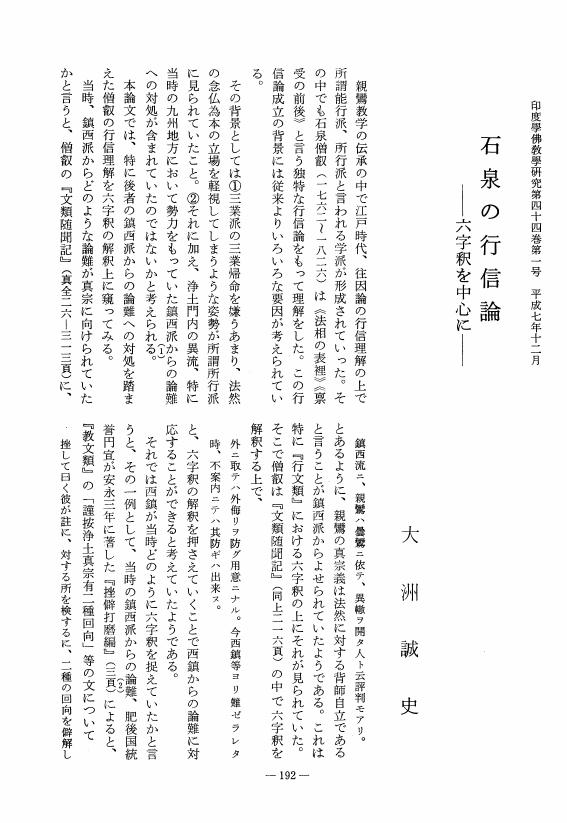1 0 0 0 OA Samaññaphalasutta (沙門果経) と Veda 祭式
- 著者
- 阪本(後藤) 純子
- 出版者
- JAPANESE ASSOCIATION OF INDIAN AND BUDDHIST STUDIES
- 雑誌
- 印度學佛教學研究 (ISSN:00194344)
- 巻号頁・発行日
- vol.49, no.2, pp.958-953, 2001-03-20 (Released:2010-03-09)
1 0 0 0 OA 変成男子考
- 著者
- 龍村 龍平
- 出版者
- JAPANESE ASSOCIATION OF INDIAN AND BUDDHIST STUDIES
- 雑誌
- 印度學佛教學研究 (ISSN:00194344)
- 巻号頁・発行日
- vol.26, no.2, pp.687-688, 1978-03-20 (Released:2010-03-09)
1 0 0 0 OA 日本的信仰構造と親鸞思想に関する考察
- 著者
- 釋 徹宗
- 出版者
- JAPANESE ASSOCIATION OF INDIAN AND BUDDHIST STUDIES
- 雑誌
- 印度學佛教學研究 (ISSN:00194344)
- 巻号頁・発行日
- vol.38, no.1, pp.54-56, 1989-12-20 (Released:2010-03-09)
1 0 0 0 OA 石泉の行信論-六字釈を中心に-
- 著者
- 大洲 誠史
- 出版者
- JAPANESE ASSOCIATION OF INDIAN AND BUDDHIST STUDIES
- 雑誌
- 印度學佛教學研究 (ISSN:00194344)
- 巻号頁・発行日
- vol.44, no.1, pp.192-194, 1995-12-20 (Released:2010-03-09)
1 0 0 0 OA 証空浄土教の思想史的区分
- 著者
- 廣川 堯敏
- 出版者
- JAPANESE ASSOCIATION OF INDIAN AND BUDDHIST STUDIES
- 雑誌
- 印度學佛教學研究 (ISSN:00194344)
- 巻号頁・発行日
- vol.32, no.2, pp.774-778, 1984-03-25 (Released:2010-03-09)
1 0 0 0 OA ラーダークリシュナン博士・哲学高等研究所設立の意義
- 著者
- 中村 元
- 出版者
- JAPANESE ASSOCIATION OF INDIAN AND BUDDHIST STUDIES
- 雑誌
- 印度學佛教學研究 (ISSN:00194344)
- 巻号頁・発行日
- vol.29, no.1, pp.11-14, 1980-12-31 (Released:2010-03-09)
1 0 0 0 OA 浄土教における大勢至菩薩の位置
- 著者
- 宇野 順治
- 出版者
- JAPANESE ASSOCIATION OF INDIAN AND BUDDHIST STUDIES
- 雑誌
- 印度學佛教學研究 (ISSN:00194344)
- 巻号頁・発行日
- vol.35, no.2, pp.596-599, 1987-03-25 (Released:2010-03-09)
1 0 0 0 OA 『天台小止観』をめぐる異文化交流
- 著者
- 一島 正真
- 出版者
- JAPANESE ASSOCIATION OF INDIAN AND BUDDHIST STUDIES
- 雑誌
- 印度學佛教學研究 (ISSN:00194344)
- 巻号頁・発行日
- vol.49, no.2, pp.851-845, 2001-03-20 (Released:2010-03-09)
1 0 0 0 OA 原始・部派仏教の食物観 -食厭想について-
- 著者
- 竹内 良英
- 出版者
- JAPANESE ASSOCIATION OF INDIAN AND BUDDHIST STUDIES
- 雑誌
- 印度學佛教學研究 (ISSN:00194344)
- 巻号頁・発行日
- vol.42, no.2, pp.917-911, 1994-03-25 (Released:2010-03-09)
1 0 0 0 OA 『不空三蔵表制集』の仏像記事
- 著者
- 服部 法照
- 出版者
- JAPANESE ASSOCIATION OF INDIAN AND BUDDHIST STUDIES
- 雑誌
- 印度學佛教學研究 (ISSN:00194344)
- 巻号頁・発行日
- vol.40, no.1, pp.79-81, 1991-12-20 (Released:2010-03-09)
1 0 0 0 宇治平等院の字輪阿弥陀咒梵字と「天竺字源」字の研究
- 著者
- 齋藤 彦松
- 出版者
- JAPANESE ASSOCIATION OF INDIAN AND BUDDHIST STUDIES
- 雑誌
- 印度學佛教學研究 (ISSN:00194344)
- 巻号頁・発行日
- vol.45, no.1, pp.110-112, 1996
- 被引用文献数
- 1
1 0 0 0 OA 三願転入の問題
- 著者
- 杉岡 孝紀
- 出版者
- JAPANESE ASSOCIATION OF INDIAN AND BUDDHIST STUDIES
- 雑誌
- 印度學佛教學研究 (ISSN:00194344)
- 巻号頁・発行日
- vol.43, no.1, pp.32-36, 1994-12-20 (Released:2010-03-09)
1 0 0 0 OA Niratman と anatman
- 著者
- 村上 真完
- 出版者
- JAPANESE ASSOCIATION OF INDIAN AND BUDDHIST STUDIES
- 雑誌
- 印度學佛教學研究 (ISSN:00194344)
- 巻号頁・発行日
- vol.19, no.2, pp.550-557, 1971-03-31 (Released:2010-03-09)
- 著者
- 村上 真完
- 出版者
- JAPANESE ASSOCIATION OF INDIAN AND BUDDHIST STUDIES
- 雑誌
- 印度學佛教學研究 (ISSN:00194344)
- 巻号頁・発行日
- vol.19, no.2, pp.550-557, 1971
1 0 0 0 OA パーリ仏教にみられる有為相をめぐる論争について
- 著者
- 上杉 宣明
- 出版者
- JAPANESE ASSOCIATION OF INDIAN AND BUDDHIST STUDIES
- 雑誌
- 印度學佛教學研究 (ISSN:00194344)
- 巻号頁・発行日
- vol.31, no.1, pp.309-312, 1982-12-25 (Released:2010-03-09)
1 0 0 0 OA 中世禅宗と葬送儀礼
- 著者
- 石川 力山
- 出版者
- JAPANESE ASSOCIATION OF INDIAN AND BUDDHIST STUDIES
- 雑誌
- 印度學佛教學研究 (ISSN:00194344)
- 巻号頁・発行日
- vol.35, no.2, pp.800-805, 1987-03-25 (Released:2010-03-09)
1 0 0 0 OA 『サーンキヤ頌』の譬喩
- 著者
- 今西 順吉
- 出版者
- JAPANESE ASSOCIATION OF INDIAN AND BUDDHIST STUDIES
- 雑誌
- 印度學佛教學研究 (ISSN:00194344)
- 巻号頁・発行日
- vol.30, no.2, pp.837-843, 1982-03-31 (Released:2010-03-09)
1 0 0 0 OA サーンキヤ頌の系譜 -第七・九頌をめぐって-
- 著者
- 今西 順吉
- 出版者
- JAPANESE ASSOCIATION OF INDIAN AND BUDDHIST STUDIES
- 雑誌
- 印度學佛教學研究 (ISSN:00194344)
- 巻号頁・発行日
- vol.8, no.2, pp.566-567, 1960-03-30 (Released:2010-03-09)
1 0 0 0 OA 日本における『金七十論』の注釈書
- 著者
- 興津 香織
- 出版者
- JAPANESE ASSOCIATION OF INDIAN AND BUDDHIST STUDIES
- 雑誌
- 印度學佛教學研究 (ISSN:00194344)
- 巻号頁・発行日
- vol.54, no.2, pp.572-575,1292, 2006-03-20 (Released:2010-07-01)
The *Suvarnasaptatisastra, which is an important treatise of Samkhya philosophy, survives only in the Chinese translation done by Paramartha 眞諦 sometime between 548 and 569. Commentarial tradition begins with the citations from it found in the Chengweishi ulun shuji 成唯識論述記, written in Tang China, and continues with a real exegetical boom in 18th century Japan. Although the Japanese exegetes refer to the same passage cited in the Chengweishi/un shuji, they express different opinions concerning the *Suvarnasaptatisastra. I analyse the interpretations of this passage in the Kin shichiju ron biko 金七十論備考 by Gyo'o Gonzo 曉應嚴藏 (1724-1785), the Kin shichiju ron sho 金七十論疏 by Chido Hoju 智幢法住 (1723-1800), the Kin shichiju ron ge 金七十論解 by Shuro 宗朗 (?-1788), and the Kin shichiju ron so kyo 金七十論藻鏡 by Rinjo Kaido 林常快道 (1751-1810) and focus mainly upon their understanding of the relation between the prose parks of the *Suvarnasaptatisastra and Vasubandhu.
1 0 0 0 OA サーンキヤ哲學に於ける「覺」について
- 著者
- 松尾 義海
- 出版者
- JAPANESE ASSOCIATION OF INDIAN AND BUDDHIST STUDIES
- 雑誌
- 印度學佛教學研究 (ISSN:00194344)
- 巻号頁・発行日
- vol.3, no.2, pp.452-456, 1955-03-30 (Released:2010-03-09)
















